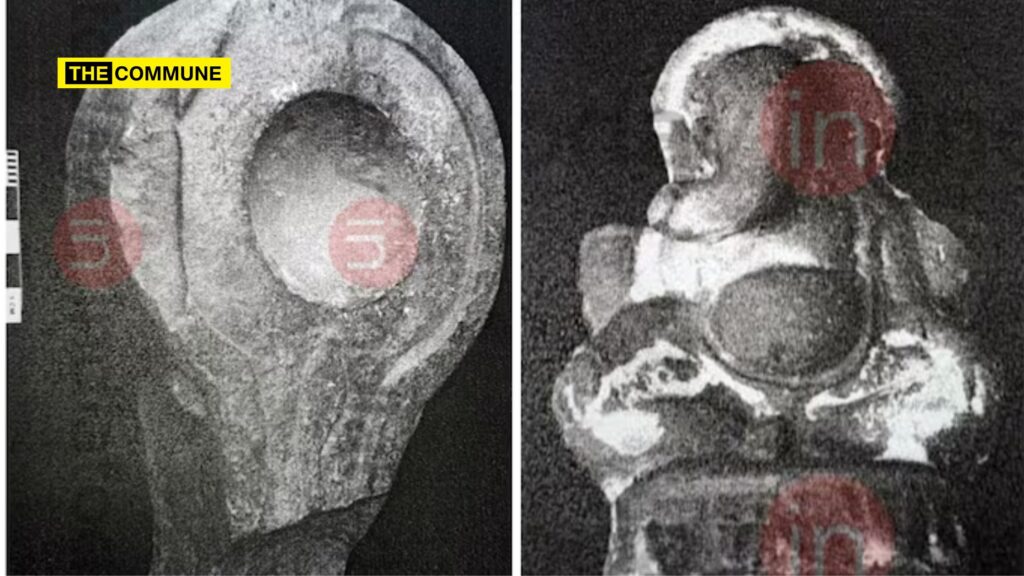Images: India Today
The Archaeological Survey of India (ASI) survey report on the Gyanvapi Mosque has infused a fresh ray of hope for Hindus. Photographs from the 839-page document provide irrefutable evidence of a pre-existing Hindu temple beneath the mosque’s imposing structure.
The detailed evidence contains pictures of revered Hindu deities like Hanuman, Ganesha, and Nandi lying desecrated within the mosque complex. The photos also reveal the discovery of several yoni pattas (the base of a Shiva ling) and a Shiva linga with its bottom part or base missing.
Advocate Vishnu Shankar Jain, representing the Hindu side, described the report’s documentation of the positions and measurements of idols at a press conference last evening.
“This inscription leaves no room for doubt – a grand Hindu temple, Adivishwara, stood tall on this very spot before its brutal destruction,” Jain said.
“A total of 34 inscriptions were recorded during the current inspection, and 32 estampages were taken. These are inscriptions on the stones of pre-existing Hindu temples which have been reused during construction of the existing structure,” Jain stated, adding that the inscriptions are in Devanagari, Grantha, Telugu and Kannada scripts.
He added that debris of idols of Hindu deities and remnants of pillars from the older temple were used in the mosque’s construction. He read out specific details within the report, including those describing inscriptions in Persian on stone slabs that provide an account of the temple’s demolition during the reign of Mughal Emperor Aurangzeb in the 17th century.
According to Jain, these findings strongly suggest the existence of a grand Hindu temple at the site of the Gyanvapi mosque. “This evidence indicates that when Aurangzeb demolished the temple of Adivishwara in the 17th century, a grand temple existed there,” he added.
The temple had a big central chamber. North, south, west chambers of the temple still exist. Central chamber of the temple forms the central hall of the existing structure
– ASI report on Gyanvapi pic.twitter.com/eaO8NeWFsT
— Nupur J Sharma (@UnSubtleDesi) January 25, 2024
These inscriptions contain three names of deities: Janardhana, Rudra, and Umesvara. The report noted that terms such as Maha-muktimandapa mentioned in three inscriptions are significant.
The temple had a big central chamber. North, south, west chambers of the temple still exist. Central chamber of the temple forms the central hall of the existing structure
– ASI report on Gyanvapi pic.twitter.com/eaO8NeWFsT
— Nupur J Sharma (@UnSubtleDesi) January 25, 2024
However, Akhlaq Ahmed, representing the Anjuman Anjamiya Masjid Committee, has categorically refuted the Hindu side’s claims. He dismissed the report’s findings as mere reiterations of what an Advocate Commission discovered during previous court-mandated proceedings.
“The only difference is that ASI has written its measurements this time. But the Hindu side’s claims are unfounded and lack expert validation,” said Ahmed.
Ahmed also questioned the Hindu side’s expertise in determining the age of the building materials. He pointed out that the ASI report itself does not specify the age of the stones.
Regarding mentioning Hindu deities in the ASI report’s photographs, Ahmed maintained that the idols found are not authentic.
Following an order of the district court passed on July 21 last year, the ASI carried out a scientific survey of the Gyanvapi premises to determine whether the mosque was constructed over a preexisting Hindu temple structure. The ASI submitted its survey report to the district court in a sealed cover on December 18.
Subscribe to our channels on Telegram, WhatsApp, and Instagram and get the best stories of the day delivered to you personally.

